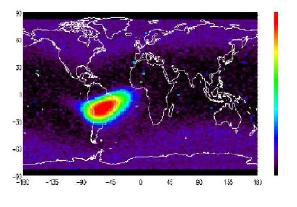 |
Without magnetosphere the planet would be directly affected by energetic particles from space.
However, there is a place on Earth poorly protected where the magnetic field has weakened
considerably. This area is located off the coast of Brazil, it is called the South Atlantic
Anomaly or SAA, it covers 7.8 million km2 (˜ 2780 km by 2780 km) and it continues to grow. |
| Geographic distribution of the geomagnetic field intensity. The
SAA boundary is around B=28000 nT. The triangle indicates the SAA
central region (Niterói-Brazil is near this region), where the geomagnetic field
intensity is the lowest. The upper circle is the point of Chacaltaya-Bolivia and
the lower point is Auger-Malargue-Argentina. |
 |
 |
Geographical distribution of proton flux measured by the
HEPAD ICARE instrument on-board the Argentinean satellite
SAC-C shows an excess (up to 10 times) of protons with
E>850 MeV in the SAA central region in comparison with the
region outside of the SAA. These high energy
protons are hard to be considered as Van Allen trapped
protons, because the SAA models such as AP8 and several
measurements of the trapped protons showed that their energies
do not exceed 300 MeV. |
| The PAMELA collaboration.
introduced a sub-cutoff in the rigidity, that is below the
nominal Stormer rigidity cutoff in the SAA area.
Downward going
protons with energies above 200 MeV are also clearly seen at
the latitudes between 400 S and 200 S (the SAA area). These
are so-called ‘quasi-trapped particles’.
|
 |